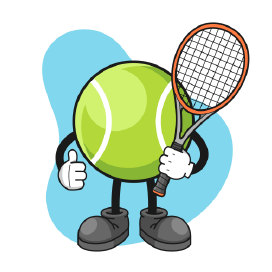Tennis String Tension Information
Are you hoping to improve your tennis game? The right string tension can make all the difference, even if you’re an experienced player.
Different tensions provide different advantages and disadvantages that affect both the playability and durability of your strings. To get the best performance from your racket, it’s important to understand the role of string tension in your equipment setup.
In this post, we’ll walk through Tennis String Tension and everything you need to know for better control over how each shot plays out on the court.
The Basics of Tennis String Tension: What Every Player Should Know?
The string tension in your tennis racket is vital because it affects the way you hit the ball. If your tennis strings are too loose, you will have less control over the ball, resulting in a lack of accuracy in your shots.
On the other hand, if your strings are too tight, you can expect more power but less spin. Therefore, it is crucial to understand the optimal string tension that suits your playing style. For any aspiring tennis player, understanding the basics of tennis string tension is crucial to enhance your game.
Understanding the Impact of String Tension on Your Tennis Game
As a tennis player, understanding the impact of string tension on your game can make all the difference in your performance. The string tension of your tennis racquet is crucial because it affects your power, control, and overall feel of the ball.
A tighter string tension will provide more control and accuracy, while a looser string tension will give you more power and spin. Each player has their own preference for string tension, and it’s up to you to find the right balance that suits your individual play style.
So, whether you prefer a more aggressive play style or a consistent one, understanding string tension can help you elevate your tennis game.
How to Choose the Right String Tension for Your Playing Style?
Choosing the right string tension is crucial for your playing style. The tension of your racquet’s strings affects your performance and ultimately your enjoyment of the game.
The right string tension can enhance your precision, power, and control. However, finding the perfect tension is not a one-size-fits-all solution. It depends on your playing style, skill level, and personal preference.
A beginner player, for instance, may prefer lower-tension strings, which offer more power and comfort. On the other hand, an experienced player may opt for higher tension strings for precise control. Therefore, it’s essential to experiment with different tensions to find what works best for your unique style of play.

The Pros and Cons of High vs. Low String Tension in Tennis
One of the most debated topics in the world of tennis is the ideal string tension to use for optimum performance. Some players prefer a higher string tension for increased control and power, while others prefer a lower tension for enhanced spin and feel.
The pros of high tension include more control over shots and more power generated, while the cons include a higher likelihood of injury and less spin potential.
On the other hand, the pros of low tension include increased spin and feel for shots, while the cons include less power and control. Ultimately, the choice of string tension comes down to personal preference and playing style.
It’s important to experiment with different tensions to find what works best for you and your game.
| Low Tension | Medium Tension | High Tension | |
|---|---|---|---|
| Pros | – Enhanced Power | – Balanced Power and Control | – Increased Control |
| – Greater Comfort | – More Spin | – Improved Accuracy | |
| – Reduced Risk of Injury | – Suitable for All Players | – Better Shot Placement | |
| Cons | – Reduced Control | – Less Power | – Higher Risk of Injury |
| – Increased Ball Vibration | – Not Ideal for Beginners | – Requires More Technique | |
| – More Frequent Re-stringing Required |
The Effects of String Tension on Spin, Power, and Control in Tennis
As a tennis player, you know that the tension of your strings can make a big difference in your game.
String tension affects everything from your ability to generate spin to your overall power and control on the court. Higher string tension means greater control over the ball, making it easier to place shots exactly where you want them.
However, it also means sacrificing some power in your swing. Lower tension strings, on the other hand, offer more power at the expense of control. Knowing how to balance these factors based on your skill level and playing style can help you fine-tune your game and take your performance to the next level.
What Is Your Perfect Tennis String Tension?
How Often Should You Re-String Your Tennis Racket Based on Tension?
One of the most important factors in maintaining peak performance from your tennis racket is keeping the strings in good condition. But just how often should you be re-stringing your racket based on tension?
It really depends on how frequently you play and how important consistency and precision are to your game. Those who play several times a week and compete regularly may want to consider re-stringing every few weeks, whereas more casual players may only need to do it a few times a year.
Ultimately, the key is to keep a close eye on the tension of your strings and make sure they don’t become too loose or too tight, which can negatively impact your ability to control the ball and hit accurately on the court.
Tips and Tricks for Adjusting String Tension to Improve Your Tennis Game
- Understand the basics: String tension refers to the tightness of the strings in your tennis racket. Higher tension provides more control and accuracy, while lower tension offers more power and spin.
- Experiment with different tensions: It’s essential to try different string tensions to find the one that suits your playing style. Start with the recommended tension range provided by the racket manufacturer and make small adjustments from there.
- Consider your playing style: If you have a powerful swing and tend to hit the ball hard, a lower tension can help maximize power and generate more spin. On the other hand, if you rely more on control and precision, a higher tension may be preferable.
- Assess your skill level: Beginners generally benefit from lower string tension as it provides a larger sweet spot and a more forgiving feel. Intermediate and advanced players often prefer higher tensions for increased control and responsiveness.
- Consult with a professional: Seeking advice from a tennis coach or stringing expert can be helpful in determining the ideal string tension for your game. They can offer insights based on your playing style, racket specifications, and personal preferences.
- Take note of string material: Different string materials (e.g., polyester, natural gut, synthetic gut) can behave differently at various tensions. Be aware of the characteristics of your chosen string material and how it interacts with tension.
- Fine-tune your tension: Once you find a tension that feels comfortable, make small adjustments (±1-2 pounds) to fine-tune your setup. Keep track of the changes and their effects on your game, allowing you to make more informed decisions in the future.
- Consider environmental factors: Keep in mind that temperature and humidity can affect string tension. Cooler temperatures can lead to slightly looser strings, while warmer conditions may cause the strings to tighten. Make adjustments accordingly.
- Re-evaluate periodically: As your game evolves, your string tension preferences may change. Regularly reassess your setup to ensure it aligns with your current playing style and skill level.
Remember, finding the optimal string tension is a personal journey, and it may take some trial and error to discover what works best for you. Be patient, stay open to adjustments, and pay attention to how different tensions impact your game.

Explore different types of tension, including the difference between high and low tensions
Tension is such a powerful force that it can either break or make you. There are different types of tension, and understanding their nuances can be a game-changer in your personal and professional life.
High tension is when there is an excessive amount of pressure, leading to stress and anxiety. It could be a result of demanding work deadlines or unrealistic expectations from others.
On the other hand, low tension occurs when there is a lack of stimulation or purpose, leading to boredom and apathy. It could be creeping in when you’re feeling stuck in a dead-end job or a stagnant relationship. By knowing how to recognize and deal with high and low tension, you can learn to harness their power and direct them toward positive outcomes.
Learn how to measure string tension in your racquet
Learning how to measure your string tension will allow you to make adjustments to customize your racquet to your specific playing style and needs.
There are a few ways to measure string tension in your racquet. You can use a tension meter, which is a device that measures the pounds of pressure on the strings when they’re strung. Another method is to use an electronic tuning fork, which emits vibrations and calculates how much tension is present in the strings. Lastly, you can measure tension by hand. This involves lightly pressing the strings with your thumb, index finger, and middle finger to gauge the amount of tension present.
No matter which method you choose to use, it’s important to be consistent in measuring string tension so that you can accurately monitor and adjust it as needed.
Find out about common misconceptions about string tension and why they’re wrong
One common misconception is that higher string tension automatically translates to greater power. However, this is not necessarily true. In fact, higher string tension can actually lead to less power and a smaller sweet spot for hitting the ball.
Another misconception is that lower string tension means a more forgiving racket that mis-hits less often. While this can be the case for some players, it all depends on individual play styles and preferences. The bottom line is that understanding the nuances of string tension is key to making the right choice for your tennis game.

To Sum Up
Ultimately, it is important to understand the basics of tennis string tension and how different tensions can affect your game. Knowing the impact of string tension on spin, power, and control in tennis allows you to tailor the grip and tension to optimize your playing style.
While a higher tension results in more control, be aware that this can come with reduced power. On the other hand, a lower string tension gives you increased power with less control and spin.
When choosing which is right for you, consider how often you should restring depending on what type of tension you choose. With some practice and experimentation, use these tips and tricks to adjust your strings to find the optimal combination that works best for you!
Frequently Asked Question
Determining the appropriate string tension for tennis is a personal preference that depends on factors such as playing style, skill level, racket characteristics, and individual comfort.
It’s recommended to try different tensions within the recommended range provided by the racket manufacturer and make adjustments based on your preferences and performance on the court.
Professional tennis players have their own preferences when it comes to string tension, and it can vary among them. Generally, pros string their rackets in the range of 45-65 pounds (20-30 kilograms) of tension.
A: The choice between low tension and high tension in tennis depends on individual preferences and playing style. Low-tension strings typically offer more power and spin due to a larger sweet spot, but may sacrifice some control.
High-tension strings provide better control and accuracy but can result in less power. It’s recommended to experiment with different tensions to find the balance that suits your game best.
Rafael Nadal is known to string his tennis racket at relatively high tension. He typically uses tension in the range of 55-60 pounds (25-27 kilograms).
Novak Djokovic prefers a slightly lower string tension compared to some other players. He typically strings his racket in the range of 48-55 pounds (22-25 kilograms), which allows for a balance between control and power in his game.
Andy Roddick, known for his powerful serves, used relatively high string tensions. He typically strung his racket at around 60-65 pounds (27-30 kilograms) to generate maximum control and power on his shots.
Andy Murray, like many other professional players, has his own preferred string tension. While specific details may vary, Murray is known to string his racket at tensions around 52-58 pounds (23-26 kilograms), providing him with a balance between power and control.
Andre Agassi preferred relatively high string tensions during his career. He typically strung his racket at around 60-65 pounds (27-30 kilograms) to enhance control and precision in his aggressive playing style.
Gael Monfils is known to use lower string tensions compared to some other players. He typically strings his racket at tensions in the range of 46-52 pounds (21-24 kilograms), which allows for more power and a comfortable feel on the court.
John McEnroe used moderately high string tensions during his playing career. He typically strung his racket at tensions around 58-62 pounds (26-28 kilograms), which offered him control and precision on his shots.
Roger Federer’s preferred string tension has varied throughout his career. He has experimented with different tensions but is generally known to string his racket in the range of 48-58 pounds (22-26 kilograms). The specific
To choose the right tennis string tension, consider factors such as your playing style, skill level, racket characteristics, and personal preference.
The ideal string tension for tennis varies from player to player. It depends on your playing style and preferences. As a starting point, you can follow the recommended tension range provided by the racket manufacturer and make adjustments based on your comfort and performance on the court.
String tension in tennis refers to the tightness of the strings within the racket. It affects the way the strings interact with the ball during play, influencing factors such as power, control, spin, and feel.
To check tennis string tension, you can use a string tension measuring device called a string tension gauge. It allows you to measure the tension of your strings by inserting the gauge between the strings and reading the corresponding tension value.
Professional tennis players have their own preferences for string tension. It can vary among players but generally falls in the range of 45-65 pounds (20-30 kilograms). However, individual players may adjust the tension based on their playing style and court conditions.
Tennis string tension can be measured using a string tension gauge. Place the gauge between the strings and read the corresponding tension value displayed on the gauge. Follow the instructions provided with the specific gauge you are using for accurate measurement.
It is recommended to start with the manufacturer’s recommended tension range for your racket. Then, experiment with different tensions within that range and assess how they affect your power, control, and feelings on the court. Make adjustments based on your preferences and performance until you find the tension that suits your game.
String tension affects a tennis racquet in several ways. Higher string tension provides more control, precision, and reduced string movement but may sacrifice some power. Lower string tension offers more power, comfort, and spin potential but can result in less control. Finding the right tension helps optimize power, control, and feel according to individual preferences.
To lower string tension in tennis, you can loosen the strings by releasing tension using a stringing machine or by visiting a professional stringer. It’s important to make small adjustments and restring the racket correctly to avoid any damage or loss of playability.





